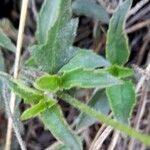Annual or perennial herb, sprawling or ascending but with erect inflorescences, 15–50 cm tall; stems scabrid-pilose, rooting at the nodes.. Leaves petiolate, narrowly ovate or ovate, often slightly 3-lobed, 2–7(–12) cm long, 1–4(–6) cm wide, base cuneate, margins coarsely dentate to incised-dentate, apex acute to acuminate, scabrid on both surfaces; petiole 4–30 mm long.. Capitula solitary and terminal, urn-shaped; stalks of individual capitula 7–25 cm long; involucre 7–8 mm long; phyllaries in 2–3 series, green, ovate and pilose; paleae linear, 6–8 mm long, pilose near apex.. Ray florets 2–6, white, cream or pale yellow, tube 3.5 mm long, pilose near apex, ray ovate, 2.5–5 mm long, 3-dentate at apex; disc florets forming a cone, yellow, 5–7 mm long, puberulous near base.. Achenes narrowly obovoid, black, 2–2.5 mm long, hairy; pappus of many unequal plumose bristles 2.5–3 mm long in marginal florets, 4–7.5 mm long in central florets.. Fig. 164 (page 765).
Annual or perennial herb, sprawling or ascending but with erect inflorescences, 15-50 cm tall; stems scabrid-pilose, rooting at the nodes. Leaves petiolate, narrowly ovate or ovate, often slightly 3-lobed, 2-7(-12) cm long, 1-4(-6) cm wide, base cuneate, margins coarsely dentate to incised-dentate, apex acute to acuminate, scabrid on both surfaces; petiole 4-30 mm long. Capitula solitary and terminal, urn-shaped; stalks of individual capitula 7-25 cm long; involucre 7-8 mm long; phyllaries in 2-3 series, green, ovate and pilose; paleae linear, 6-8 mm long, pilose near apex. Ray florets 2-6, white, cream or pale yellow, tube 3.5 mm long, pilose near apex, ray ovate, 2.5-5 mm long, 3-dentate at apex; disc florets forming a cone, yellow, 5-7 mm long, puberulous near base. Achenes narrowly obovoid, black, 2-2.5 mm long, hairy; pappus of many unequal plumose bristles 2.5-3 mm long in marginal florets, 4-7.5 mm long in central florets.
Procumbent perennial herb, (5–) 30–60 (–90) cm high; stems striate, coarsely hispid, rooting at lower nodes. Leaves with petiole 5–10 (–20) mm long; lamina lanceolate to ovate, (20–) 25–40 (–80) mm long, (6–) 10–20 (–50) mm wide, coarsely toothed, coarsely hispid. Capitula radiate, solitary, terminal, 10–15 mm diam. (excluding rays); peduncles (15–) 20–30 cm long; outer involucral bracts herbaceous, hispid; inner bracts membranous, striate, often purplish, hairy near rounded apices; paleae lanceolate, acute, membranous, straw coloured, glabrous. Ray florets 5 or 6, pale yellow to white; ligules 4–5 mm long, deeply 3-lobed at apex, shortly pilose abaxially. Disc florets shortly pilose, yellow. Achenes narrowly obconical, c. 2 mm long, long-pilose. Pappus bristles c. 20, c. 6 mm long (those of ray florets shorter), widened at base, plumose.
Herbs, annual to perennial, caulescent, decumbent. Stems procumbent, branched at base, branches slender, spreading or ascending, 20-50 cm, hirsute. Leaves few, shortly petiolate; blade ovate to ovate-lanceolate, 2.5-5 cm, base cuneate, margin deeply irregularly serrate, pinnatisect, segments few, narrow, apex acute or acuminate. Capitula solitary, 1-1.5 cm in diam.; peduncle 10-30 cm; involucre subcampanulate, 6-7 mm; phyllaries few seriate, hispid, outer densely grayish white, elliptic, ca. 5 mm, long hirsute, inner tinged purplish, narrower, ca. 6 mm. Ray florets 4, white. Disk florets yellow, tube ca. 5 mm, limb 5-lobed, lobes reflexed, hairy. Achenes brown, oblong, ca. 2 mm, densely silky pubescent; pappus setae 5-6 mm, shiny, plumose. Fl. Nov-Mar. 2n = 36.
A low growing herb. It grows 10-40 cm tall. The leaves are the shape of arrow heads and have teeth along the edge. The flowers are like daisy flowers and white or yellow. The fruit is heard and covered with hairs. These seeds can blow in the wind and spread rapidly.
Trailing, hairy annual or perennial herb. Leaves rhomboid-ovate, margins coarsely and irregularly toothed, petiolate. Heads solitary on long, nude peduncles. Flowers with whitish or creamy yellow rays, disc yellow or greenish; January, May to June and in September.
Leaves: petioles 1–10(–30) mm; blades 10–40(–120) × 5–20(–60) mm, often 3-lobed. Cypselae 2–2.5 mm; pappi 4–5(–7.5) mm. 2n = 36.
A low herb with weak trailing branches and long-stalked flower-heads about 1/2 in. long
Ray-florets cream-coloured, drying yellow; disk-florets yellow, often tinged reddish












